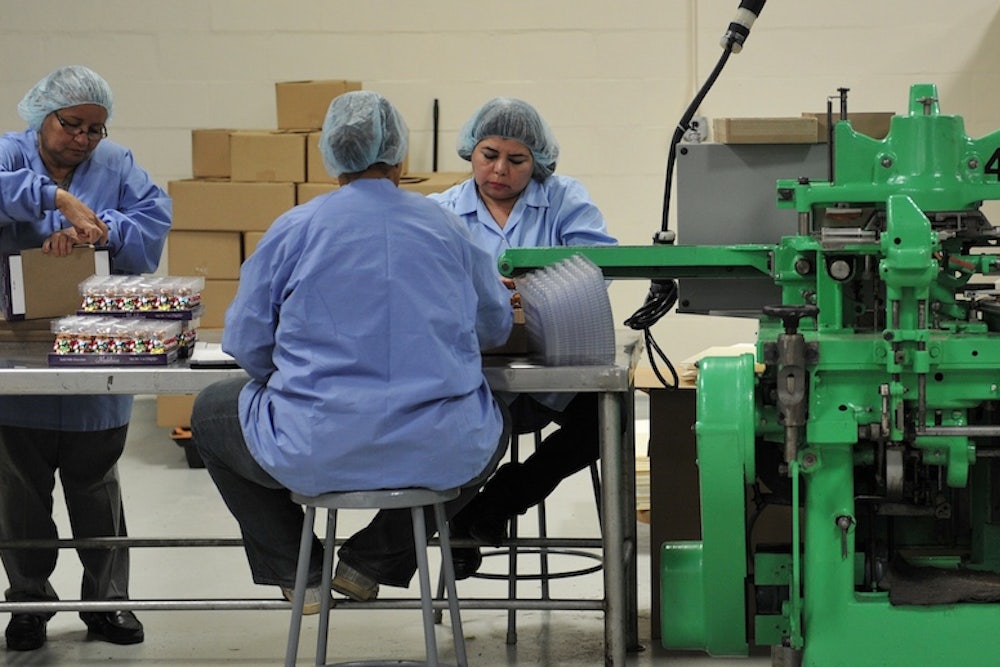A remarkable piece of news came out along with last month's job report—of the 74,000 jobs added to the U.S. economy in December, all of them went to women.
Women today are definitely doing better than they were in the depths of the recession—in between June 2009 and February 2011, private-sector employers hired 503,000 men, while 141,000 women lost their jobs. But the December jobs number still isn't necessarily good news for women in the workforce. Most of the job gains in December were "concentrated in low-wage sectors," and women already make up nearly two-thirds of minimum wage earners in the country.
As Stephanie Coontz wrote in a recent op-ed, the problem for women in the workplace isn't the glass ceiling so much as the "sinking floor." While gaining ground in higher-paying sectors, women continue to vastly outnumber their male counterparts in low-wage jobs. This has led to a barbell effect, with the number of women in middle-sector jobs shrinking. So perhaps, to further stretch the metaphor, the problem isn't the glass ceiling or the sinking floor, but the contracting walls of the trash compactor in Star Wars.
Still, women remain economically resilient. They have recouped all of the jobs they lost during the recession, Coontz writes, while men have regained only 75 percent of them. But one in three women—42 million—lives in poverty or is "teetering on the brink," according to a recent report on women and poverty. Even Beyoncé weighed in.
It's hard to pinpoint one reason why women make less money than men, but being the default caretaker, choosing to (or being forced into) lower-wage professions, and being the subject of run-of-the-mill sexism are all part of the economic potpourri. The push for a living wage and associated benefits would help assuage the problems all low-income earners face, but a more nefarious, gendered question persists: Why are women, systemically, more likely to work in lower-wage job sectors?
Women workers, for example, are concentrated in education and health care—job sectors that are more stable than, say, construction, but are also relatively low-paying. But despite being relegated to (or choosing work in) lower-paying job sectors, women are still more likely to have a college education than men and control the majority of spending and health care decisions in their families.
"Social and economic policies constructed around the male breadwinner model have always disadvantaged women," Coontz writes. "But today they are dragging down millions of men as well. Paradoxically, putting gender equity issues at the center of social planning would now be in the interests of most men."
Economics is not a zero-sum game, because humans tend to depend on each other to live. Only one in five families have a full-time male breadwinner and female caretaker, and a lack of childcare services bears a cost for working men, too—unlike in the 1950s, one breadwinner doesn't cut it anymore. Mandatory paid maternity leave and paid sick leave, for which there is no federal requirement, would be a boon to working mothers and fathers alike.
Women are, comparatively, a steal for employers—they're likely to have a college education, yet are less likely to ask for a raise. Still, companies are more likely to offer men jobs for similar qualifications. How to explain, then, the number of jobs awarded to women in December? The simple answer would be that employers prefer to employ men, but men are being out-qualified by women.
While pay gaps continue to persist between men and women in almost every job sector, Hanna Rosin debunked the popular stat that "women make 77 cents on the dollar compared to men"—it's more like 91 cents on the dollar:
The point here is not that there is no wage inequality. But by focusing our outrage into a tidy, misleading statistic we’ve missed the actual challenges. It would in fact be much simpler if the problem were rank sexism and all you had to do was enlighten the nation’s bosses or throw the Equal Pay Act at them. But the 91 percent statistic suggests a much more complicated set of problems. Is it that women are choosing lower-paying professions or that our country values women’s professions less? And why do women work fewer hours? Is this all discrimination or, as economist Claudia Goldin likes to say, also a result of “rational choices” women make about how they want to conduct their lives.
"Why buy the cow when you can get the milk for free?" goes the gross aphorism about marriage. Despite that flawless logic, men, incredibly, continue to marry women they have slept with. Some employers seem to apply the same type of logic to their female employees: Why offer paid maternity leave when we can just find someone else to fill the position? Why offer paid sick leave when our competitors don't?
There's no compelling economic answer to that, at least not for a single employer (on a macro level, paying more consumers more money is good for the economy prima facie). But that's because it's not essentially an economic question; it's a human one. And while the employer-employee relationship presents an entirely different dynamic from marriage, the same opportunity to recognize women's worth—as employees, as agents of our modern economy, and as human beings—is there.
